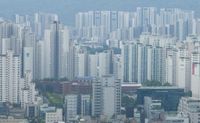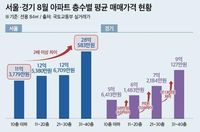South Korea’s bustling metropolitan region is in the midst of a fierce debate over the future of its urban landscape, as residents, local governments, and developers grapple with a mounting housing shortage and the contentious route of the planned Wirye-Gwacheon Line. The stakes are high: the outcome will shape the lives of tens of thousands, determine the value of prime real estate, and set the tone for how the country balances growth, equity, and infrastructure in its most coveted districts.
According to a report published on October 7, 2025 by Chosun Ilbo, the heart of the dispute lies in the newly proposed residential developments in the Wibuk and Cheonsun areas, with two major residential complexes on the horizon. These projects are part of a government strategy to alleviate a persistent housing shortage that has gripped the Seoul metropolitan area, particularly in the affluent districts of Gangnam, Seocho, and Banpo. The Korea Development Institute Public Investment Management Advisory Center (KDI PIMAC) announced in November 2024 a sweeping plan to supply new housing to meet surging demand.
The centerpiece of this effort is the development of so-called ‘Y-type residential complexes’ in the Cheonsun area, especially in the district’s western reaches. The plan emphasizes high-density, efficient urban planning, with a total of approximately 28.25 kilometers of new urban development stretching across the eastern and northern parts of the city. The goal? To provide homes for roughly 40,000 residents, a significant boost for an area where the current population hovers around 15,000.
But as the government and local authorities coordinate to ensure supply meets demand, the process has been anything but smooth. The proposed route for the Wirye-Gwacheon Line—a major transit artery designed to serve these new developments—has become a flashpoint for local rivalries and competing interests.
The original plan, which passed a rigorous private investment feasibility assessment by KDI PIMAC in November 2024, envisioned a ‘Y-shaped’ line. This route would start at Gwacheon Racecourse Park, weave through Seocho’s Umyeon-dong, and connect to Apgujeong and Bokjeong stations. The proposal, put forward by Daewoo Engineering & Construction and Sambo Engineering, was publicly presented by the Ministry of Land, Infrastructure and Transport earlier this year as the preferred option. It would cut through the heart of Gwacheon, pass near the Yangjae Citizen’s Forest, and serve not only new residents but also commuters to major tech campuses like Samsung and LG’s Yangjae R&D centers.
“Daewoo Engineering & Construction must have reviewed various routes before settling on this one, which shows they believe demand is highest here,” an industry insider told Chosun Ilbo. The route’s backers point to its ability to serve the largest number of commuters and maximize economic efficiency—a key consideration in a city where every new subway stop can transform a neighborhood overnight.
Yet, not everyone is on board. Gwacheon city officials and many of its residents favor an alternative: a route that would begin at the Gwacheon Cultural Center, skirt the racecourse, cut through the Juam district, and head toward the Yangjae Interchange. This path, notably, would pass directly in front of a parcel earmarked for a high-tech urban logistics complex being developed by Harim Group. The fact that Gwacheon’s mayor, Shin Gye-yong, met with Harim Group’s chairman, Kim Hong-guk, in April only fueled speculation about backroom deals and special interests swirling around the project.
Gwacheon has put its money where its mouth is, pledging 400 billion won (about $300 million) from regional transportation improvement funds to lure the line through Juam. Local politicians have thrown their weight behind the plan, escalating tensions between the cities.
Meanwhile, residents of Seocho’s Umyeon-dong are digging in their heels. Last month, 15,000 of them signed a petition urging the Ministry of Land, Infrastructure and Transport to stick to the original plan. “Among all administrative districts in Seoul’s Seocho-gu, only Yangjae 1-dong (Umyeon-dong) and Naegok-dong lack a subway station,” said one resident, Park, as quoted by Chosun Ilbo. “We need the Wirye-Gwacheon Line as planned to shed our reputation as a transit desert.”
This isn’t just a battle over train stops. The Wirye-Gwacheon Line, first proposed by a Daewoo-led consortium in 2021, is part of the government’s fourth national rail network plan. It’s a vast private investment project stretching 28.25 kilometers, connecting the Government Complex Gwacheon in the west, Songpa’s Legal Town in the east, and Apgujeong in Gangnam to the north. The line is meant to knit together new residential zones, boost property values, and—crucially—help absorb the population influx that comes with massive new housing developments.
And the pressure is only mounting. As reported by Maeil Business Newspaper on October 7, 2025, housing prices in the metropolitan area have soared, pricing out many would-be homeowners and creating intense demand for new supply. The government has responded with plans to develop about 12 million square meters of new residential land, focusing on Gangnam and Seocho. Among the headline projects is ‘Aqua Seocho,’ a sprawling 1.72 million square meter development with 1,161 housing units, set to be completed by August 2026.
Public housing is also a key part of the equation. The Korea Land and Housing Corporation (LH) is overseeing the construction of nearly 15,994 public housing units nationwide, with 11,922 slated for the greater Seoul area. In the hotly contested Juam district of Gwacheon, public housing will hit the market in December 2025, including 120 units in C1 Block and 812 in the ‘Newlywed Hope Town’—a sign of the government’s push to help young families and first-time buyers find homes close to the capital’s economic heart.
Location is everything. The new developments in Gwacheon’s Juam district boast easy access to Seoul’s Gangnam district, proximity to key subway lines (including the planned Wirye-Gwacheon Line and GTX-C), and the promise of large, green residential zones surrounded by Mount Umyeon and Mount Cheonggye. If both the Juam and neighboring Gwacheon districts are developed as planned, the area could transform into one of the region’s most desirable addresses.
But for all the optimism, challenges remain. The government’s strict lending restrictions—such as the unprecedented 600 million won ($450,000) cap on final mortgage loans—mean that only those with significant cash reserves can afford to buy in the most coveted districts. As Maeil Business Newspaper points out, this could lead to disappointment for some buyers, while making the new supply all the more attractive for those able to compete.
As the debate rages on, one thing is clear: the outcome will have lasting consequences for the region’s urban fabric, social equity, and economic vitality. Whether the Wirye-Gwacheon Line follows the original Y-shaped route or bends to political and commercial pressures, the battle over Seoul’s housing future is far from over.
With new developments set to reshape the skyline and long-standing neighborhoods vying for a place on the map, the next year will be pivotal for residents, developers, and policymakers alike.

